It seems we can’t find what you’re looking for. Perhaps searching can help.
Sign Up for newsletter!
Subscribe to get the latest eBook!
Hotline






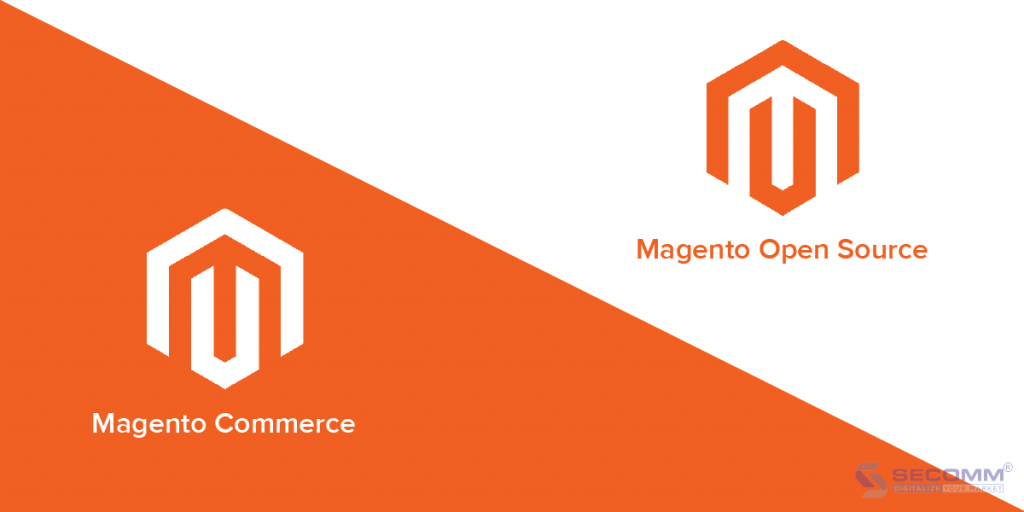
With over 200,000 websites worldwide, Magento is today’s most widely used eCommerce platform. Magento is always the best choice for businesses to use because of the benefits of open source code and specialized features for the eCommerce market.
Businesses must carefully study the strategy and consider the needs of the website system when deciding between Magento Open Source and Magento Commerce to implement eCommerce on the Magento platform.
Magento Open Source was initially known as Magento Community Edition (CE), a free version of the Magento open source platform. This version provides a flexible framework for building eCommerce websites, which is popular among many businesses.
.

Magento Commerce, formerly known as Magento Enterprise Edition (EE), is a website system used by large businesses with complex website system requirements.
This instance provides an on-premises solution as well as a hosted solution as a service (Magento Commerce Cloud), which aids in website performance and user experience. As a result, the annual fee for using this version is $24.000.

The platform will charge an additional $2.000/year for the included hosting service when using Magento Commerce to ensure that the business’s website system is constantly updated and upgraded, allowing it to handle high traffic and bills of lading more quickly.
Meanwhile, Magento Open Source is free to select a hosting provider that meets the business’s requirements and budget.

The following table compares the features that distinguish the two versions of Magento:
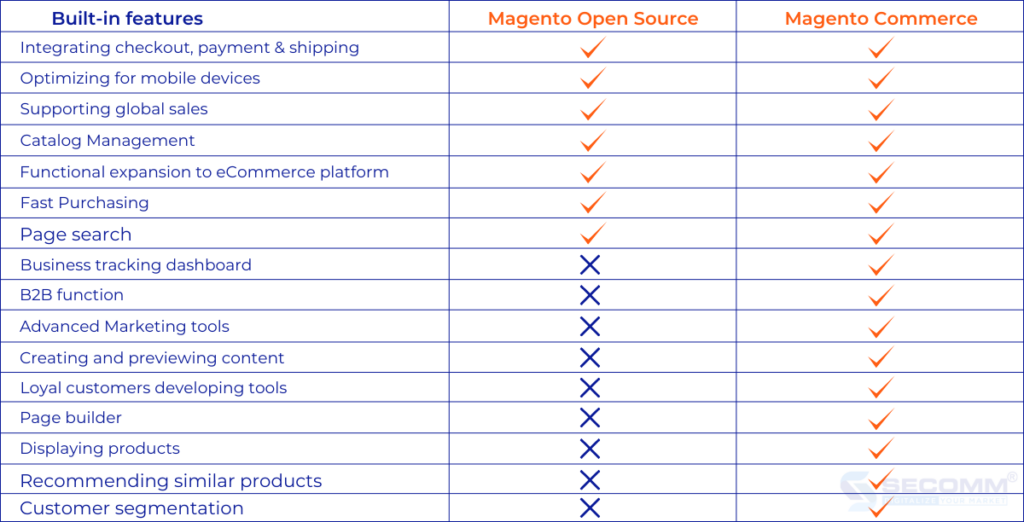
Magento Open Source has fewer features than Magento Commerce because it is a free version. Businesses, on the other hand, businesses can build the necessary functions themselves using extensions from the Magento ecosystem, the community of extension developers, or the project developers with whom Magento collaborates.
Magento Open Source will require a lower investment than Magento Commerce, from hosting and domains to website development. Nevertheless, the technology infrastructure is the same, so the costs of interfaces and extensions are calculated similarly.
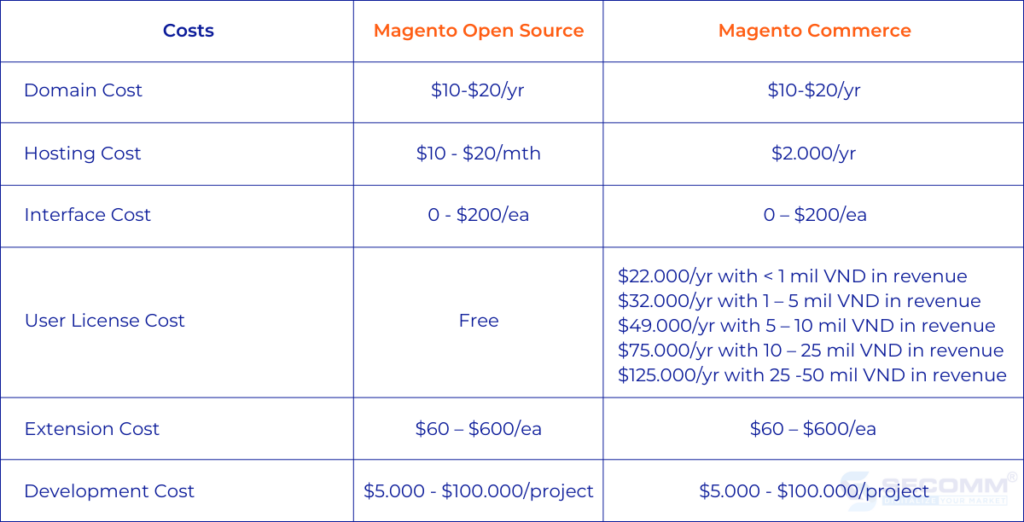
While Magento Commerce provides global technical support, including cloud service integration, Magento Open Source is not directly supported by the Magento technical team. However, the current Magento Open Source website developers continue to ensure expertise so that the business website is constantly updated and effectively operated.
Magento Open Source will be ideal for startups, SMEs (small and medium enterprises), businesses new to eCommerce, and even large corporations that do not yet require Magento Commerce’s advanced functionality system. Because using Magento Open Source is advantageous:
Meanwhile, Magento Commerce will be appropriate for large businesses because:

Choosing the best Magento version will be determined by each company’s long-term eCommerce strategy. However, it is also critical to implement those versions. They must collaborate with professional Magento developers to consult on and implement the best eCommerce solution.
With in-depth experience and developing many complex eCommerce systems on Magento, SECOMM understands the obstacles in choosing a platform and implementing Ecommerce businesses face.
Get in touch with us now for FREE eCommerce development consultancy and solutions
 2
2
 7,484
7,484
 0
0
 1
1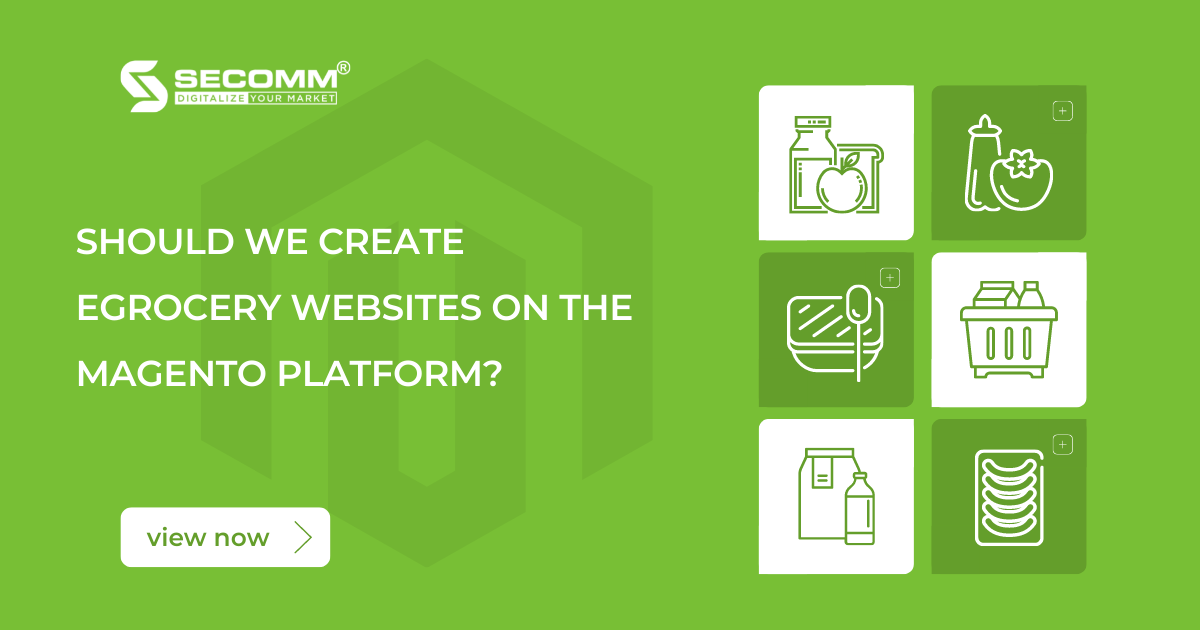
The growth of the grocery eCommerce industry in the Vietnamese market in 2021 is undeniable. According to the Google report, online grocery-related searches will increase by 223% in 2021, 3.6 times in June, and 11 times in July during Vietnam’s lockdown due to Covid-19 in several provinces.
Recognizing the market’s enormous potential, the need for a professional eCommerce website for online grocery businesses has grown significantly to expand the business system, supporting digital transformation and long-term revenue growth. Some of Vietnam’s largest grocery businesses, including Annam Gourmet Market, Bach Hoa Xanh, Organica, Farmer’s Market, and WinMart, have led the way in developing an eCommerce website system and have seen great success.
Choosing the right platform to build an eCommerce website makes the above brands successful. Platforms play a significant role in developing and operating an effective online grocery website. Along with well-known names such as Shopify, BigCommerce, and WooCommerce, Magento is considered the best online grocery support platform.
Businesses have many options when designing the eGrocery website interface on the Magento platform, including using available themes, customizing themes, and creating their own.
Businesses can find Magento-specific themes in the grocery field, developer community, or partner using available themes. It helps businesses reduce the cost of interface design, but it limits businesses’ brand positioning because the interface is easy to duplicate with other websites.

Businesses can save money and add brand identity elements such as colors, fonts, layout, and so on by customizing their themes. However, businesses need a team with extensive Magento expertise and experience to set up and customize the interface efficiently.
Businesses will have a one-of-a-kind website for their brand if they design their interface. However, it will require an enormous investment in development costs and a professional team.
When choosing Magento to develop an eCommerce website, most grocery stores often customize or use their themes to support an in-depth eCommerce business.
The Magento platform provides a comprehensive set of features, ranging from basic to advanced, for the development of professional eCommerce websites. Additionally, Magento allows you to create custom functions to solve specialized grocery industry problems.
Basic functions to assist businesses in running an efficient and smooth website system, such as
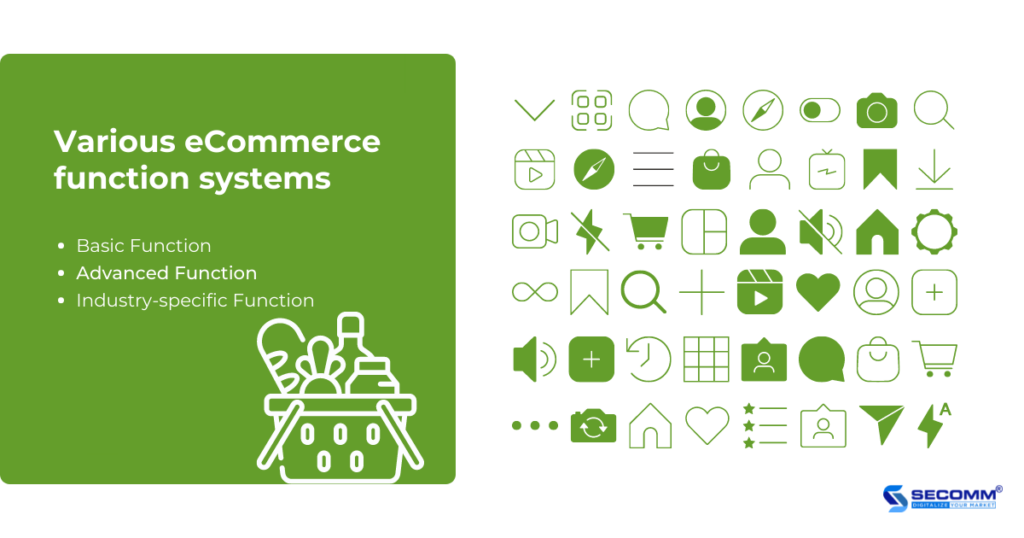
Advanced functions that improve consumers’ online shopping experiences, such as advanced search (Elasticsearch, live-search), MSI (Multi-Source Inventory), abandoned cart, similar product recommendations, PWA (Progressive Web Apps), multi-layered product catalog, and so on.
In addition, industry-specific functions assist businesses in dealing with their problems and reducing mistakes in the online grocery industry, such as order tracking, fast delivery, delivery time and location options, etc.
The high flexibility of Magento open source is an outstanding advantage that helps the system not only operate effectively at present but also expand the system to accompany businesses in the future.
Grocery businesses can fully integrate 3rd party services with Magento, making eCommerce operations efficient and smooth:
Marketing: Integrating with marketing software from Email Marketing (Mailchimp, Getresponse) to advertisement (Facebook, Google, Zalo, Tik Tok) to optimize eCommerce business
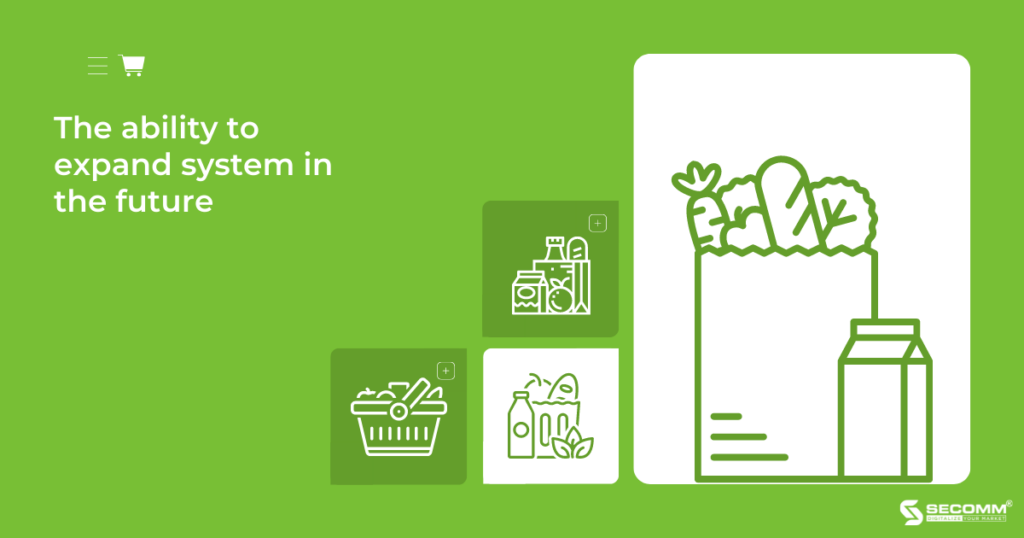
Besides that, Magento also allows businesses to expand from one website, and one store to many websites, and stores, and convert multi-language, and multi-currency flexibly while still being able to manage all data at the same time.
As a result, Magento is a suitable platform for a wide range of business models, including B2C, B2B, B2B2C, and O2O, as well as a wide range of business sizes, including new businesses entering the eCommerce market, startups, SMEs (small and medium enterprises), and large corporations.
In the path to building a website, security is another significant benefit that makes the Magento platform the preferred platform for online grocery stores.
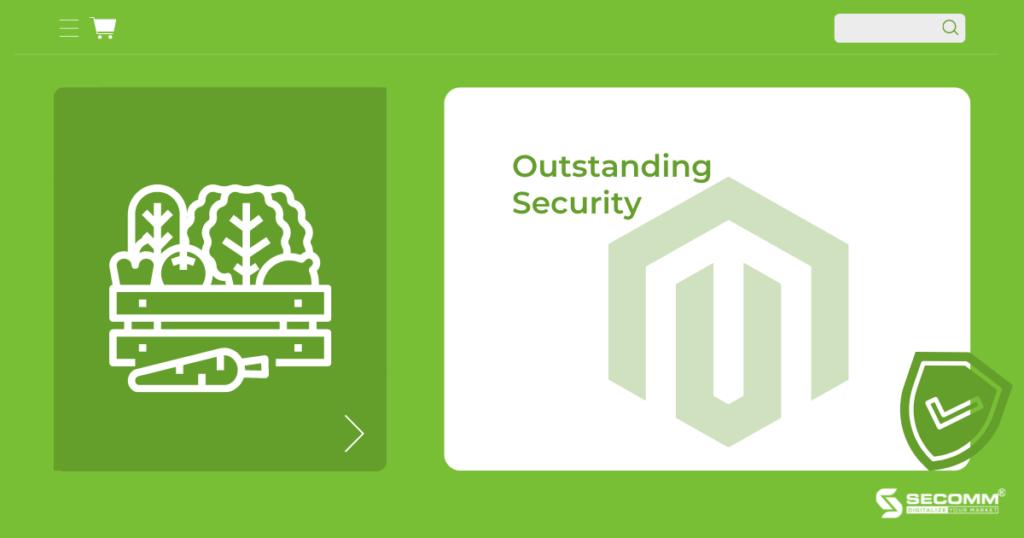
Magento includes a security scan tool that helps identify problems and propose security solutions to handle arising errors, effectively optimizing the security of grocery eCommerce websites. Moreover, to improve admin account security, Magento requires admins to use advanced passwords with at least 7 characters, including letters, numbers, and special symbols. Simultaneously, password complexity can be added to lowercase and uppercase passwords or re-login after a certain amount of login session time. Furthermore, Magento supports two-factor authentication, such as OTP or CAPTCHA code, to strengthen the security of the grocery eCommerce website system.
The Magento platform has a worldwide developer community that includes many experienced and professional Magento developers.
Magento is also part of the Adobe ecosystem, helping businesses easily access new technology trends and use Adobe’s available application store.
With such a strong development community, online grocery store businesses will receive the most assistance in resolving technical issues and consulting on building eCommerce solutions that are appropriate for their business model.
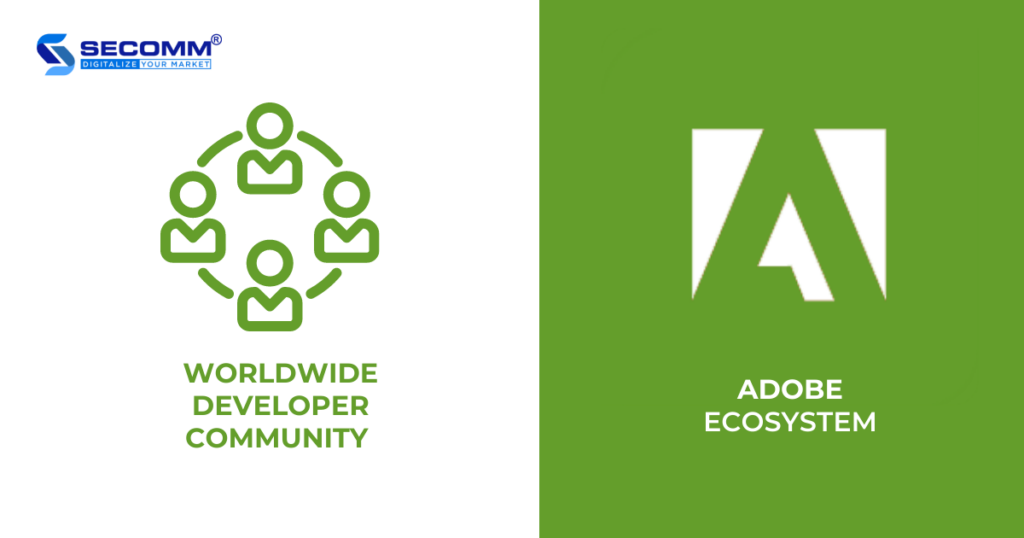
Although Magento is highly appreciated for its features and performance, the cost issue is still a significant obstacle that makes many eGrocery businesses hesitate to choose Magento.
Implementing a complete eCommerce website system built on Magento costs between $10,000 and $250,000.
| Cost | Magento Open Source | Magento Commerce | Magento Commerce Cloud |
| User licenses | Free | $22.000 -$125.000/yr | $40.000-$190.000/yr |
| Hosting | $100-$500/yr | $500-$6.500/yr | Free |
| Domain | $10-$400/yr | $10-$400/yr | $10-$400/yr |
| SSL Certificate | $50-$300/yr | $50-$300/yr | $50-$300/yr |
| Creating website | $5.000+ | $5.000+ | $5.000+ |
| Developing website | $1.800-$10.000/yr | $10.000+ | $10.000+ |
| Extensions | $60-$600/ea | 60-$600/ea | 60-$600/ea |
| Total | $10.000-$17.000 | $33.000-$149.000 | $50.000-$207.000 |
The table comparing Magento construction costs
A complete Magento project typically requires 3 to 6 months, with some projects requiring up to a year. As a result, businesses frequently waste time because of the complex functional system and the scarcity of Magento experts.
Businesses require a professional team with a deep understanding of Magento as well as practical experience on highly complex systems to implement an effective eGrocery website using Magento.
Although Annam Gourmet has previously owned a website, it is primarily used for brand development, and the effectiveness of eCommerce activities has not been prioritized. As a result, this website system is not comprehensive and is limited to crucial eCommerce functions. Furthermore, to transition into the “new normal”, Annam Gourmet must expand its online sales channel more intensively and effectively.
In order to meet the needs mentioned earlier, as well as to support the company’s long-term development goals in the Vietnamese market, Secomm and Synova successfully built a complete eCommerce website system on the Magento 2 platform.
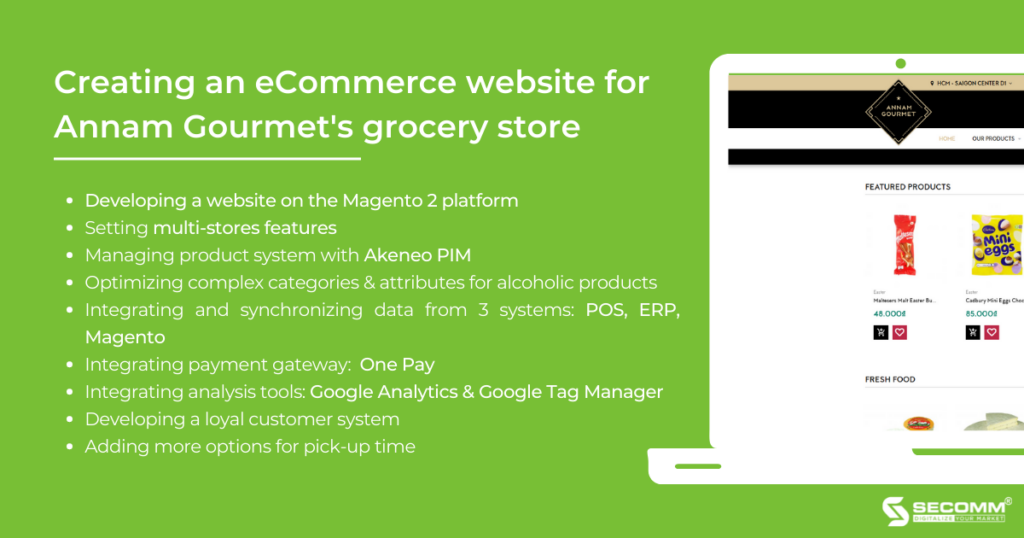
The Magento 2 website system is operationally stable and effective with other components in Annam Gourmet’s operating system. As a result, Annam Gourmet’s eCommerce website, with typical grocery industry elements, is capable of meeting all business needs, such as operating effectively in a highly complex system, quickly processing huge amounts of data about products, customers, and orders, and seamlessly syncing with ERP, CRM, POS, and so on.
In general, when building a grocery eCommerce website with Magento, businesses can master everything from interface design to feature system, leveraging a diverse ecosystem, a system capable of flexible customization, and superior security. On the other hand, businesses must prepare and invest in a budget, time, and team to successfully and effectively implement it.
Our company – SECOMM, has been partnering with many big enterprises such as An Nam Group (Vietnam), Jasnor (Australia), and Changi Airport Group (Singapore). As a result, we are aware of the challenges and worries firms face while developing an eCommerce website system.
Get in touch with us now for FREE eCommerce consultancy and solutions in eGrocery businesses.
 2
2
 4,425
4,425
 0
0
 1
1
The first workshop of TECH TALK 2020, in other words, had a great sharing time making the team connect closely. Thus, Secommers not only have time together but also got new Magento knowledge. Thanks to the framework of Ms. Ivy, the team had the opportunity to share those foundation topics:
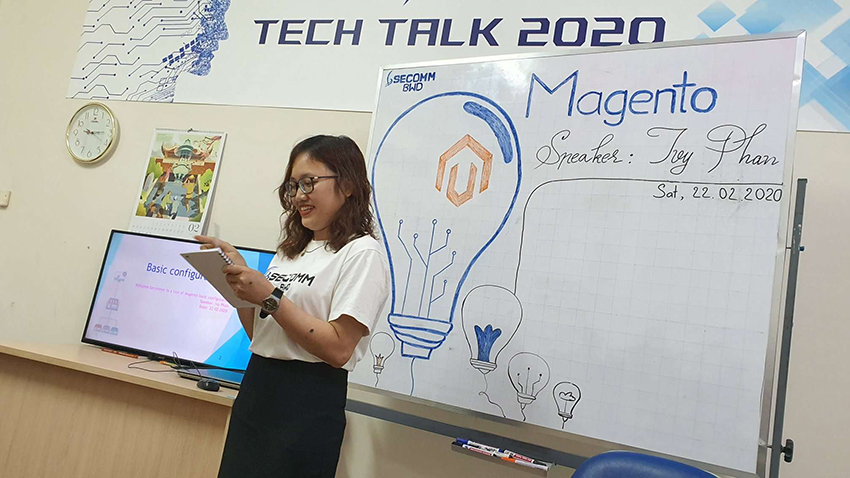

 2
2
 3,085
3,085
 10
10
 1
1
A huge range of Magento functions not only conquers the interest of the web developer community but also reigns the world as one of the leading ecommerce platforms. Talking about its various highlight power, the ecommerce market is probably the place to get benefits from this platform.
With the amazing benefits of PWA, Magento developers cannot afford to miss this special opportunity. Then, Magento PWA Studio was born as an interface solution for ecommerce websites based on the Magento platform. With fast page load time, optimal performance, Magento PWA Studio has provided the best user experience, making ecommerce web pages more reliable and consistent across devices.
One of the salient advantages of Magento is the ability to add more extensions depending on specific user needs flexibly. That highlight makes Magento very suitable for different online businesses with various commerce activities. With this feature, website developers can integrate most extensions, including free or paid versions, to customize Magento with the best performance.
One of the important functions of the open-source platform is to integrate features supporting SEO maximization. Magento is considered to be a platform that implements SEO tools completely from product catalogs to independent products.
Let’s take a look at the timeline of Magento from the very first launching in 2007 to the new upgraded versions during 2011 – 2018.
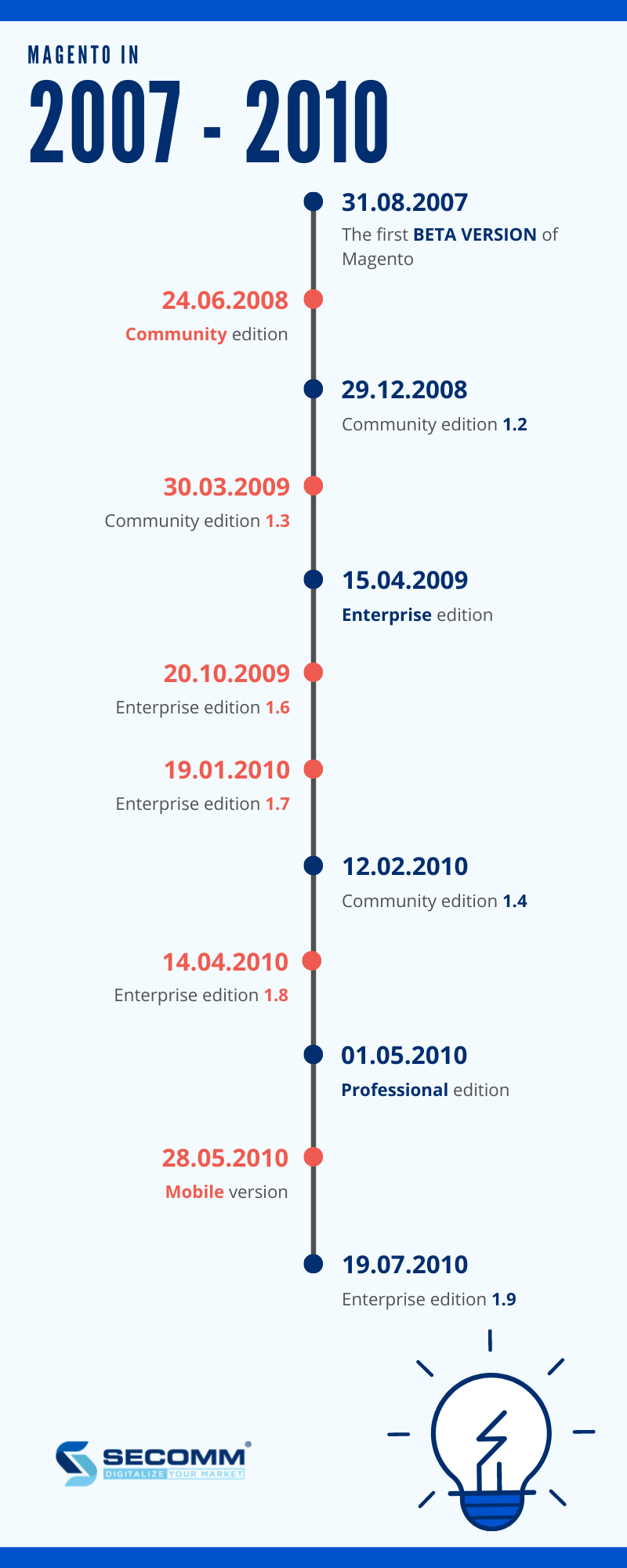
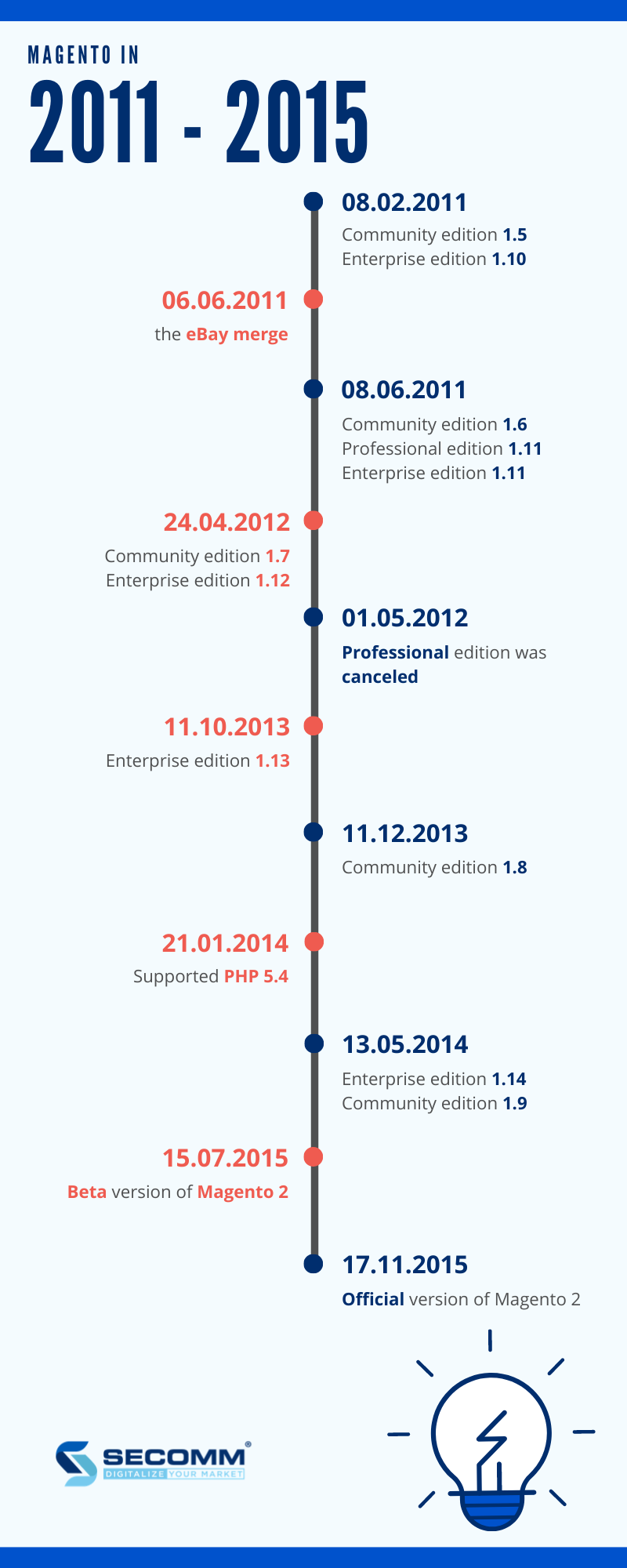
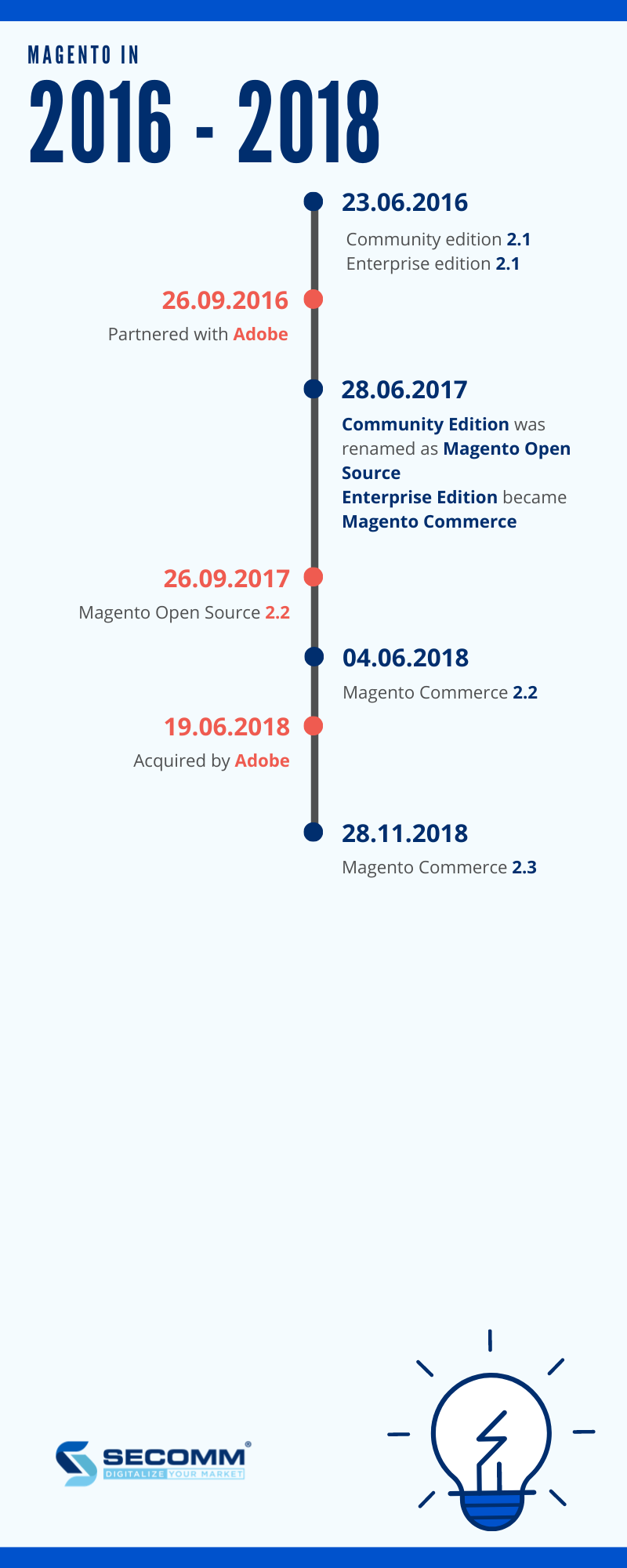
Still, the platform is constantly being improved to meet the Magento user community’s diverse needs around the world. Truly, Magento has brought a lot of convenience and breakthroughs to the ecommerce website development industry. Below are magnificent facts about Magento you may not know.
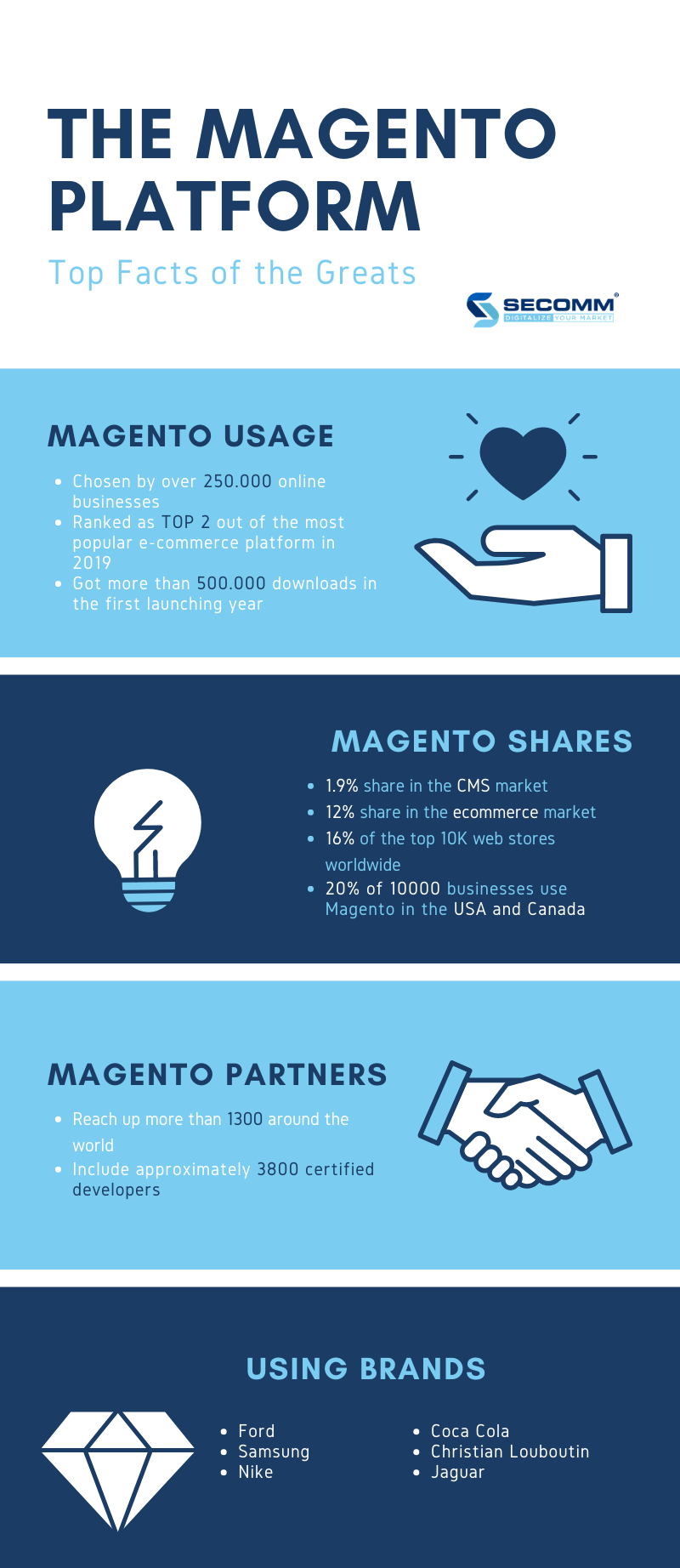
With 8-year-experience in Magento, our SECOMM team has used Magento effectively to create solutions for partners/businesses. Magento timeline includes a huge amount of needs for the user community: beautiful and diverse themes, UI/UX design, security, effective cost, and so on. Especially in Vietnam, Magento is exactly the perfect tool to help ecommerce businesses control most of the features for online stores.
 2
2
 5,168
5,168
 10
10
 1
1Subscribe to get the latest eBook!
Hotline